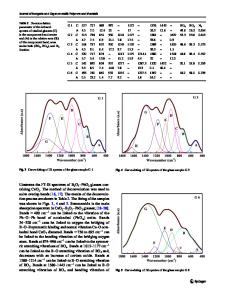ZnO/Al 2 O 3 Core-shell Nanorod Arrays: Processing, Structural Characterization, and Luminescent Property
- PDF / 295,171 Bytes
- 9 Pages / 595.22 x 842 pts (A4) Page_size
- 25 Downloads / 335 Views
1144-LL19-13
ZnO/Al2O3 Core-shell Nanorod Arrays: Processing, Structural Characterization, and Luminescent Property C. Y. Chen,1 C. A. Lin,1 M. J. Chen,2 G. R. Lin,1 and J. H. He1,* 1 Institute of Photonics and Optoelectronics, and Department of Electrical Engineering, National Taiwan University, Taipei, 10617 Taiwan 2 Department of Materials Science and Engineering, National Taiwan University, Taipei, 10617 Taiwan ABSTRACT We reported the aqueous chemical method to fabricate the well-aligned ZnO/Al2O3 coreshell nanorod arrays (NRAs). The shell is composed of α-Al2O3 nanocrystals in amorphous Al2O3 layers. The photoluminescence (PL) measurements showed that the enhancement of nearband-edge emission in ZnO NRAs arrays due to the addition of Al2O3 shell was observed. The Al2O3 shell layer resulting in flatband effect near ZnO surface leads to a stronger overlap of the wavefunctions of electrons and holes in the ZnO core, further enhancing the NBE emission. INTRODUCTION Due to the ultrahigh surface-to-volume ratio characteristics of nanowires/nanorods (NWs/NRs) [1], significant progress has been made for the fabrication of various electronic, optoelectronic, and sensor devices [2-6]. Since the performance of a nanodevice critically depends on the surface of nanomaterials, the investigation of surface effect is vitally important for fully utilizing the advantages offered by nanomaterials. ZnO has been devoted to novel optoelectronic devices duo to their unique properties such as large excitation binding energy (60 meV), near ultraviolet UV emission, transparent conductivity, and piezoelectricity [7]. Engineering of the ZnO NWs/NRAs-based device through surface modification can maximize the effects or benefits provided by nanostructures. For practical applications, the growth of controlled NRAs is vitally important for applications such as field emitters [8], nanogenerator [9], solar cell [10], and nanolasers [11]. The most popular method used for growth of ZnO NRAs is to use Au as catalyst and a single crystal substrate, such as a-plane alumina. The close lattice and symmetry match between the substrate surface and the ZnO results in epitaxial vertical growth of NRAs [12]. Moreover, various complex nanostructures [13-17] have been synthesized with the modification of optical properties. However, a study on the ZnO/nanocrystal-embedded (NC-embedded) Al2O3 core-shell NR arrays (NRAs) has not been investigated. ZnO/Al2O3 core-shell structure is attractive because it is wafer-scale assembly by all aqueous chemical methods. In addition, Al2O3, being a high-k dielectric material, may also act as the gate dielectric of ZnO nanowire transistors [18]. Since the bandgap of Al2O3 is larger than that of ZnO and the refractive index of Al2O3 is lower than that of ZnO, it suggests that the optical property of ZnO can benefit from Al2O3 coating [17]. In this work, we reported the chemical method, advantageous for low reaction temperature, low cost, minimum equipment requirement, atmospheric pressure and product homogeneity, to fabric
Data Loading...











